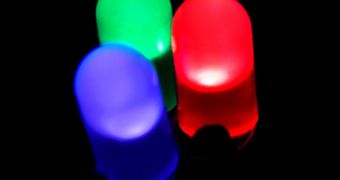The first Light-Emitting Diodes (LEDs) were produced in the mid 1920s and have been used extensively ever since, in electronic applications around the world, like lights and signals for traffic, railroads, cars, flashlights and generally every appliance that needs a light source.
The color of the emitted light depends on the composition and condition of the semiconducting material used and can be infrared, visible or near-ultraviolet, but until now, all LEDs were able to produce a single wavelength, be it blue, green, red, or of other colors.
Now, a team of scientists led by Manfred Helm, of Dresden-Rossendorf Research Institute, in Germany, created a silicon LED that can rapidly alternate between producing red and blue light. This was possible by adding certain rare earth metals.
They are built from a layer of semiconducting silicon and a layer of insulating silicon dioxide, which forms an electronic barrier made of silicon dioxide, with a thickness of only 100 nanometers, to control the flow of electrons. Then, the rare earth metal Europium (Eu) is implanted within the silicon dioxide.
The only way to allow electrons to cross the nanoscale barrier is to apply a voltage across the barrier itself, a process known as tunneling. During this process some of the electrons flowing through silicon hit the europium atoms, which sends them to a higher energy state. When these atoms fall back to their original state, they emit light.
"We had worked on silicon devices doped with one rare earth metal, but they only emit one color," says Helm. Now they were able to demonstrate that LEDs can actually produce two colors using only one doping element, which can exist in two different chemical states, that modifies the element's reaction to electrons to produce the two colors.
The next step of the project is to dope silicon with both europium and another element, terbium, which can be made to light up green, which will produce the ideal LED. This will be able to produce all three major colors in one device and all the others will be synthesized from these, through fluctuations of the electrical current.
There's no shortage of practical applications for the wonder LED, few of them being smaller pixels in higher-resolution displays and optoelectronic devices that can receive signals in both light and electricity.

 14 DAY TRIAL //
14 DAY TRIAL //